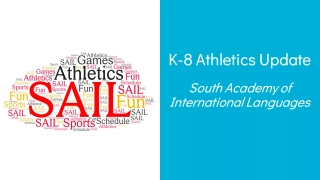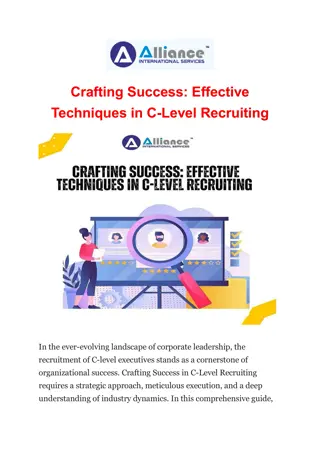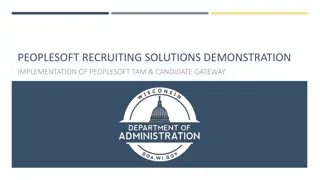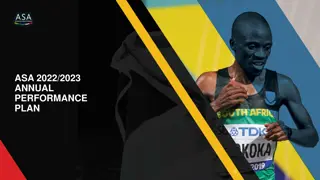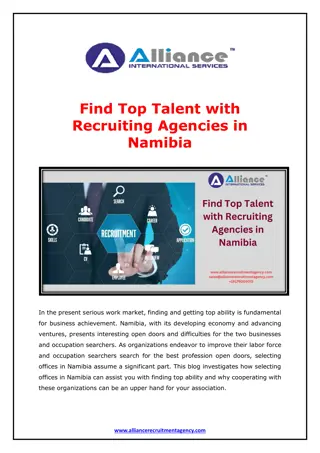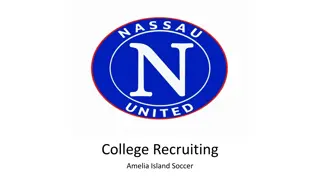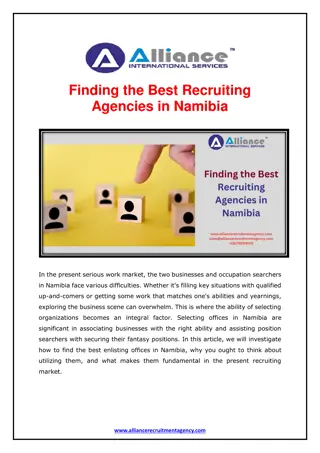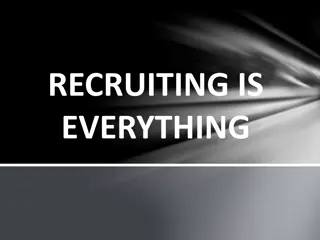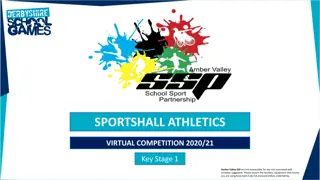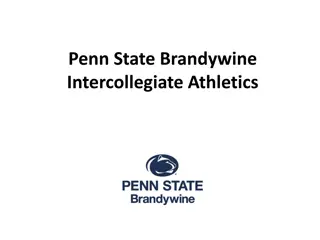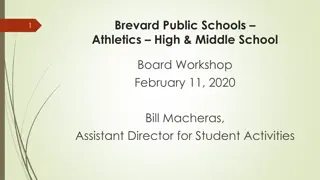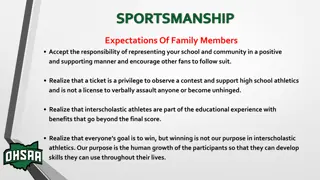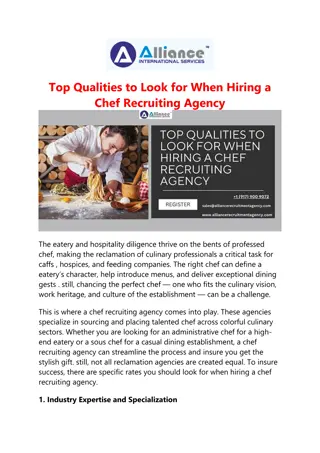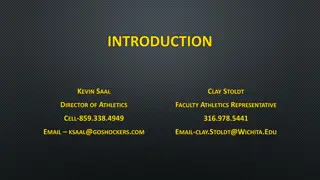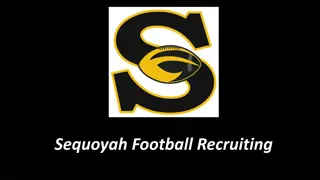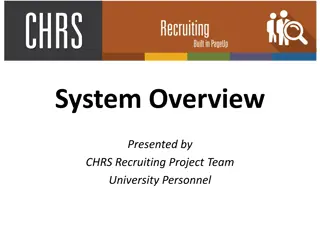Athletics and Recruiting Webinar
Join our webinar on athletics and recruiting to gain valuable insights into the world of sports recruitment. Learn about important strategies, tips, and resources to enhance your recruitment process. Whether you're a student-athlete or a coach, this webinar will provide useful information to help you navigate the recruiting landscape successfully.
Download Presentation

Please find below an Image/Link to download the presentation.
The content on the website is provided AS IS for your information and personal use only. It may not be sold, licensed, or shared on other websites without obtaining consent from the author.If you encounter any issues during the download, it is possible that the publisher has removed the file from their server.
You are allowed to download the files provided on this website for personal or commercial use, subject to the condition that they are used lawfully. All files are the property of their respective owners.
The content on the website is provided AS IS for your information and personal use only. It may not be sold, licensed, or shared on other websites without obtaining consent from the author.
E N D
Presentation Transcript
Athletics and Recruiting Webinar
Presentation Overview STAB Athletics During COVID Fall Recap Winter and Spring Preparation Navigating recruiting process for student-athletes NCAA/NAIA Eligibility Center NCAA rule changes as it relates to COVID Differences in recruiting strategies during the pandemic Guidance for families entering the recruiting process Student-athlete must do s for recruiting
Guiding Principles Physical, mental, and emotional benefits of physical activity on the student experience Safety and well-being of our students and coaches Programmatic excellence, continuity of program objectives and aspirations Interscholastic Athletic Strategic Plan
Athletics Through COVID Fall athletics Fall physical activity and sports started September 8 Recap of LIS/VPL decision o Girls Tennis/ Coed cross country o Added Golf Sports Offered Interscholastic competition in tennis, cross country, and golf Non competitive practices in football, volleyball, field hockey, and soccer Non competitive classes in yoga, strength and conditioning, and outdoor wellness
Athletics Through COVID Athletic Plans Moving Forward Condensed three season model allowing brief period for fall competitions in Feb and March US Winter sports start December 14 7th/8th winter sports start January 11
Continued Considerations Health and Safety the priority Protocols and Procedures Role of testing Competition standards State and conference decisions Recommendations from the CDC and Health Officials Impact of COVID on aspiring collegiate athletes
St. Annes Aspiring Collegiate Athletes Dewayne Robinson, Director of Athletics Rachel Booth, Associate AD for Facilities and Student Services Sandra Sohne Johnston, Director of College Counseling Your Varsity Head Coach
Navigating the recruiting process Prerequisites for being a collegiate athlete Ask yourself Do I have the athletic ability to compete at college? Do I have the DESIRE to compete in my sport for another four years? Reasons athletes don t get noticed by college coaches Timing start the process early Unrealistic expectations Lack of initiative Be proactive Never say never, Never say always
Goals for the student-athlete 1. Receive a Quality Education 2. Rewarding Athletic Experience 3. Comfortable Campus Environment Finding a school where the student-athlete can grow as an individual If you were to have a season/career ending injury, would you still be happy at this institution?
Sports at the College Level Many options to play sports in college Opportunities for a large majority of student-athletes Purpose of Divisions Create a more level playing field in intercollegiate sports Divisions gives smaller schools with fewer resources the opportunity to compete for championships NCAA Division I, II, and III http://www.ncaa.org/ The Ivy League https://ivyleague.com/ NAIA National Association of Intercollegiate Athletics https://www.naia.org/landing/index NJCAA National Junior College Athletics Association https://www.njcaa.org/landing/index
Recruiting Terms to Know Contact Contact Period college coach may have face-to-face contact, watch student-athletes compete, visit high schools, and write or telephone. Evaluation Period college coach may watch, visit high schools, and write or telephone student-athletes. College coach may not have face-to-face contact. Quiet Period college coach may only have face-to-face contact on the college s campus. A coach may not watch student-athletes compete (unless a competition occurs on the college s campus) or visit high schools. Coaches may write or telephone. Dead Period college coach may not have face-to-face contact and may not watch student-athletes compete or visit their high schools. Coaches may write and telephone. any time a college coach says more than hello during a face-to-face contact.
Official Visit vs Unofficial Visit Official Visit Visits to a college campus paid for by the college Transportation to and from the college Lodging Three meals per day for both the prospect and the parent or guardian Reasonable entertainment expenses including three tickets to a home sports event Unofficial Visits paid for by student-athletes or their parents College can provide three tickets to a home sports event
National Letter of Intent Signed by student-athlete and agrees to attend a Division I or II college or university for one academic year Participating institutions agree to provide financial aid for one academic year as long as the student-athlete is admitted to the school and is eligible for financial aid under NCAA rules Voluntary and not required for a student-athlete to receive financial aid or participate in sports Ends the recruiting process If a student-athlete signs a National Letter of Intent with one school but attends a different school, he or she will lose one full year of eligibility and must complete a full academic year at their new school before being eligible to compete.
Core Course Requirements Not all high school classes count as core courses Approved core courses: English, math (Algebra 1 or higher), natural or physical science, social science, foreign language, comparative religion or philosophy Can earn credit for core course only once Must complete 16 core courses upon graduation 10 core courses must be completed by the 7th semester Earn at least a 2.3 GPA Calculated based on core courses through Eligibility Center Earn a combined SAT or ACT score that matches your GPA on sliding scale
NCAA/NAIA Eligibility Center NCAA Eligibility Center (as known as the Clearinghouse) Certifies all academic and amateur credentials of all student-athletes who wish to compete at the DI and DII level DIII student-athletes are not certified by the Eligibility Center Register no later than sophomore year of high school https://web3.ncaa.org/ecwr3/ NAIA Eligibility Center Required for student-athletes to play in the NAIA Ensures student-athletes meet academic requirements https://play.mynaia.org/
Academic Certification Outcomes Division I Early Academic Qualifier Full Qualifier Nonqualifier Academic Redshirt http://fs.ncaa.org/Docs/eligibility_center/Student_Resources/DI_ReqsFactSheet.pdf Division II Full Qualifier Nonqualifier Partial Qualifier http://fs.ncaa.org/Docs/eligibility_center/Student_Resources/DII_ReqsFactSheet.pdf
Academic Certification Outcomes Academic Redshirt (DI only) May receive an athletics scholarship during their first year of full-time enrollment Can practice during their first regular academic term Can NOT compete during their first year of enrollment Complete 16 core courses GPA at least 2.0 Nonqualifier may NOT practice or compete with your team or receive an athletics scholarship during your first year of full-time college enrollment Partial Qualifier (DII only) May receive an athletics scholarship during their first year of enrollment Can practice during their first year of full-time enrollment May NOT compete Complete 16 core courses GPA at least 2.0
What about DIII? Division III college or university determines its own eligibility for: Admission Financial aid Practice and competition Eligibility Center does not perform certifications for DIII athletes Registering in Eligibility center is not required
Academic Certification - COVID Impact Distance or E-learning During 2020-21 academic year: o Eligibility Center will not require a separate review of distance or e- learning programs o Policy will apply to students from all grade levels (e.g., freshmen, sophomores) who complete distance or e-learning courses Standardized testing requirements Standardized test excluded from NCAA initial eligibility criteria for students who initially enroll full time in an NCAA school during the 2021-22 academic year. IMPORTANT: Colleges and/or scholarship programs may still require test scores regardless
Normal Standardized Testing SAT - score is calculated by adding critical reading and math subscores ACT - score is calculated by adding English, math, reading and science subscores Expectations in a normal year Eligibility center uses sliding scales to determine academic status based on GPA and SAT/ACT scores May take the SAT or ACT an unlimited number of times before he or she enrolls full time in college
Academic Certification - COVID Impact Pass/Fail Grades Pass = 2.3 value If student GPA would increase by assigning a value of 2.3, this value will be assigned to the passed courses If by assigning a value of 2.3 for a pass decreases student GPA, letter grades will only be used
Impacts of COVID Recruiting Imposed Recruiting Dead Period Impact on Students Expectations Impact on Normal Recruiting procedures o Virtual campus tours, digital recruiting, minimized recruiting boards Programmatic and Budgetary Implications Schedules Program Support Scholarships Program Disbandment
Questions to Ask How many senior athletes are returning for an extra year? Have your scholarship numbers been impacted due to COVID? Has the amount of financial aid your school offers been impacted? Do you anticipate any lingering shifts to future recruiting classes? Are there other things I should be thinking about? Are you giving virtual tours or providing opportunities to meet current athletes in the program?
What they expect of you Do the work Be consistent (email, send info, respond in timely fashion) Target a list of colleges Be realistic Express why you think you are a good fit academically and athletically Send in video clips o Mix of highlights and areas where you have and will improve Follow up
Tips for tackling the process Focus on the process Look at all options and levels Stay in touch with your high school coaches and admin Update your videos Monitor your social media presence Be professional in all communication Create a list of questions to ask Find a way to get on coaches radars Take advantage of summer and showcase opportunities Film, Film, Film
Student Advice Focus on the things you can control: (1) Take care of your grades, and prepare yourself academically. If you do not hit certain NCAA, conference and institutional benchmarks (both prior to and during college), you will not be allowed to compete, regardless of how athletically talented you are. (2) Make sure your social media reflects the type of quality person you are. Especially now, coaches and administrators want student- athletes who will be good teammates and positive influences on and off the field/court. (3) Be honest with yourself about whether college athletics is what you really want. Being a student-athlete is as challenging as it is rewarding. Do your homework so you know exactly what you are signing up for. - Jim Phillips - Northwestern University, Athletics Director
Differences in recruiting during pandemic Evaluations Evaluations are occurring through film and conversations with high school and club coaches. To be honest I am surprised to say this: this summer s evaluations of video instead of live attendance has made our staff more prepared and knowledgeable about the recruits. Being able to return to past films and focus in on specific recruits from the comfortable confines of my dining room has allowed us to be better rested and more streamlined with our recruiting approach. Of course, we realize not every recruit is on this past summer s recruiting circuit. But for those that were, we can access and re-watch a great deal of film. - Lars Tiffany, UVA Men s Lacrosse Coach More live-streaming of events
Final Thoughts Recruiting process takes time Maintain realistic expectations Take initiative Start compiling film for recruiting video Educate self on various athletic divisions and conferences Begin to create your school wish list
Resources College Coaches College specific websites NCAA NAIA NJCAA Guide for the College Bound Student Athlete NCAA Covid-19 Updates NCAA Eligibility Center / Hotline: 877-262-1492 NAIA Eligibility Center NCAA Recruiting Terms NCAA Time Management Expectations Dewayne Robinson, drobinson@stab.org Rachel Booth, rbooth@stab.org


